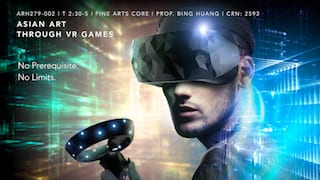by The Cowl Editor on November 8, 2018
Arts & Entertainment
by: Sara Conway ’21 A&E Staff

Dr. Bing Huang, a professor of art & art history, recently sat down with The Cowl to discuss her new course, coming up this spring, entitled ‘Asian Art through VR Games.’
Sara Conway (SC): What inspired you to teach a class based on Virtual Reality?
Professor Bing Huang (BH): It’s virtual reality, it’s a technical achievement, but mainly it’s fun! You will find the future where people are having the most fun. I want to bring the most cutting-edge visual technology to Providence College students. The experience of VR is bringing us closer than ever to science fiction. Not everyone has experienced VR, and as yet very few colleges offer VR courses. I got my first VR Oculus developer headset four years ago even before it was commercialized. MIT was one of the first places to teach this technology and that was where I learned it with Professor Takehiko Nagakura. I’ve always been fascinated by digital innovation and transformation.
I am an art historian and I feel that art truly revolves around the technology or media of its time. If you think about the art of our day, museums and galleries are important and the first thing that comes to mind, but I do not confine contemporary art to museums or other art institutions. I think that our contemporary art involves gaming, movies, and social media (such as Instagram and Facebook). These are the biggest warehouses of images and should be considered the contemporary art of our age. Everyone can be an artist and self-made internet celebrity, and create great content for our modern image consumption.
VR is one step forward. It is the art of the future. On the surface, this outer world is available to us only through sensory streams, but VR affects our cognitive consciousness on a deeper level. In this course, the students can walk into new dimensions and experience worlds without limits. It raises the question: are visual consciousness and bodily self-consciousness related to each other? If all of our senses were to be replaced with virtual ones, would reality be replaced too? Why play a game when you can live it?
What this class wants to reveal to the student is that they are not only playing games but also creating games. I remember, last year, one of my students whose name was Thomas Begley ’18, after learning how to paint bamboo in Chinese painting, created a Chinese bamboo grove in virtual reality. Another student in the class put on the goggles for the first time and was teleported to the bamboo grove that Thomas had created. It was truly a full body, wholly immersive experience.
SC: In what ways does VR enhance the learning experience for students who have had little exposure to Asian art?
BH: Historically, we consider the best way to experience art and architecture is to stand in front of the original. For one thing, VR is helpful when the original is inaccessible. Moreover, experience through VR can be redesigned and made more breathtaking and educational than would be standing in front of the original. That is why I created the Asian Art through VR Games course. This course aims to create a new experience based on VR games to facilitate the understanding of Asian Art.
I’ve already created several VR games while at MIT. For example, there’s Ancient Chinese Architecture, Buddhist Caves, Emperors’ Tombs and Japanese Temple. Students can play games which will allow them to feel like they are in ancient Japan and China. The experience is very real, and the closest thing to actually being in Japan and China. More than that, you’re inside a time capsule of ancient Asia, with your entire mind and body immersed in virtual worlds where reality and imagination mix in breathtaking, hyper-realistic experiences. One second, you’re standing in a PC classroom and the next you’re in a Japanese garden. You’d have to experience it to understand it fully.
SC: What do you think is going to be your favorite aspect about teaching this class?
BH: What’s exciting for me about teaching in general and teaching this course in particular is being able to interact with the students. The greatest thing about being a professor is the students. I truly treasure the time that I spend with my students. They are curious and produce an unceasing stream of innovation. I look forward to seeing what my students are going to create on this course. I will be thrilled to fly drones and make VR movies with my students. With more than half of American adults and four-in-five young adults now estimated to play digital games on a regular basis, this course provides a strong humanities education backed by virtual reality technology. Knowing how to create VR content will place these students in a highly advantageous position with regard to the job market upon graduation.